Note: Edits added 1/24/2012, added in italics, and bold, below.
There’s been precious little sewing, and even less sewing blogging, around here lately. There’s always a long list of things that need doing, not many of which require needle and thread. Here’s one of them; I decided to post it because I think that anyone who can sew can probably handle this particular bit of home repair. It was actually kind of fun, and I loved not paying a plumber a hundred bucks or more to install it. Here’s our old kitchen faucet, dating (I think) from around 1970:
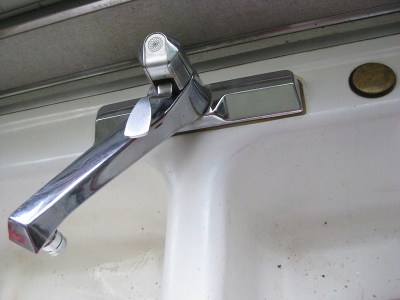 It’s ugly, it’s never been maximally useful, and it developed a loathsome drip. We’ve always hated having a faucet that was so low — almost on level with the top of the sink — since it’s difficult to get deep pans under it. I decided I’d rather replace it than deal with taking it apart just to fix the leak.
It’s ugly, it’s never been maximally useful, and it developed a loathsome drip. We’ve always hated having a faucet that was so low — almost on level with the top of the sink — since it’s difficult to get deep pans under it. I decided I’d rather replace it than deal with taking it apart just to fix the leak.
So I trotted over to Lowe’s and found a new one. As it turned out, there weren’t many options for us; at all of the hardware stores in our area, there were only two faucets that would work in our particular situation. (I’ll explain that later.) Most people won’t have that much trouble finding a replacement. Figuring out which one to buy isn’t usually a problem either; in general, sinks have standardized holes in the stainless or porcelain. You just need to know the number of holes, and the configuration.
I found a faucet assembly that would work, got the tool kit out of the basement, cleared out the cabinet, and reached in to turn the water off. And couldn’t. The valve handles wouldn’t budge. Stymied at the first moment! The first step for this home repair project, much to my surprise, involved these tools:
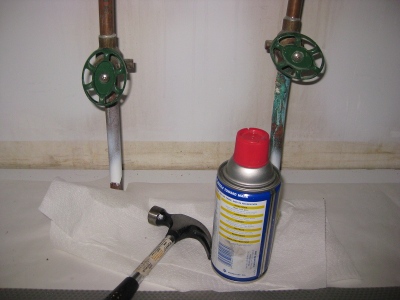 WD-40 is my best friend. When using it, tap gently, or you’ll end up calling the plumber after all. It took only a couple of minutes’ work before I was able to turn the handles. With the water lines closed off, I crawled into the cabinet and peered under the sink:
WD-40 is my best friend. When using it, tap gently, or you’ll end up calling the plumber after all. It took only a couple of minutes’ work before I was able to turn the handles. With the water lines closed off, I crawled into the cabinet and peered under the sink:
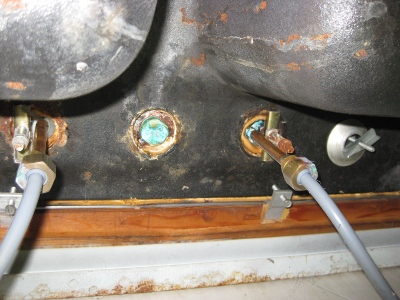 Ours is a four-hole sink, but the 1970s faucet uses only two (you can see the water lines above, one hot, one cold, which go to the appropriate faucet handle). The fourth hole, on the far right, holds a brass plug in place over the hole where a sprayer would go. Yeah, that sink needs replacing, too, along with the 1952 counter, but that’s a project for another time.
Ours is a four-hole sink, but the 1970s faucet uses only two (you can see the water lines above, one hot, one cold, which go to the appropriate faucet handle). The fourth hole, on the far right, holds a brass plug in place over the hole where a sprayer would go. Yeah, that sink needs replacing, too, along with the 1952 counter, but that’s a project for another time.
I reached up and unscrewed the rather weird little rods holding the faucet in place. There was nothing else keeping the faucet assembly steady, so I went slowly, making sure that I could ensure that the assembly would end up resting on its side, instead of falling into my porcelain sink and chipping it. If your sink is in better shape than mine, you might want to hedge your bet a little and line it with a towel against damage.
Under the faucet was horrifying:
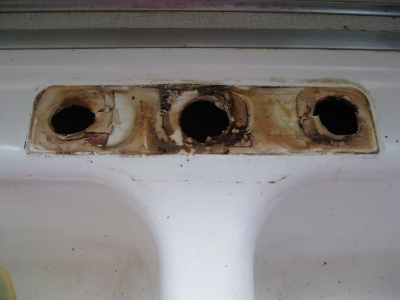 Blech! Getting rid of this, alone, would have been a good reason to replace the old faucet. Weirdly, all of these deposits and the grime scrubbed off very nicely — without even much effort. I used a non-metal scrubber, cleanser, and polished like mad. It was beautiful when I finished, which apparently amazed me so much that I forgot to take a picture.
Blech! Getting rid of this, alone, would have been a good reason to replace the old faucet. Weirdly, all of these deposits and the grime scrubbed off very nicely — without even much effort. I used a non-metal scrubber, cleanser, and polished like mad. It was beautiful when I finished, which apparently amazed me so much that I forgot to take a picture.
Once the surface was clean, I placed the new faucet assembly into the holes. (I debated scrubbing off the rust underneath, but couldn’t bring myself to do it. There’s a stainless steel sink in our future.) Here’s what the assembly looked like from the underside:
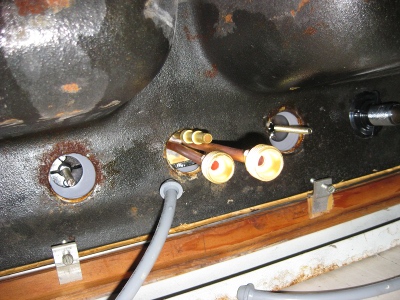 The new faucet is just set in place here. The gray water hose on the left isn’t connected; it’s just sitting there. See the threaded steel post on the right, just above the whitish connectors? There’s another one on the left, though you can’t see it as well. Those posts are what holds the faucet in place. This is possibly the kludg-iest connecting system imaginable, but it’s also exactly the one that held the 1970s assembly in place, so apparently it’s got tradition going for it.
The new faucet is just set in place here. The gray water hose on the left isn’t connected; it’s just sitting there. See the threaded steel post on the right, just above the whitish connectors? There’s another one on the left, though you can’t see it as well. Those posts are what holds the faucet in place. This is possibly the kludg-iest connecting system imaginable, but it’s also exactly the one that held the 1970s assembly in place, so apparently it’s got tradition going for it.
Here are the parts that get attached to those posts:
The little round tube is a spacer. You twirl the rectangular bits onto the posts until they are braced against the bottom of the sink. Wacky, no? It does seem to work, although it looks pretty dicey:
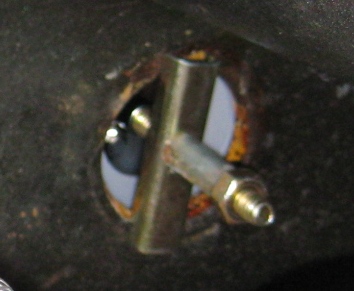 You can see the rectangular bit, the tube, and the nut that holds them in place.
You can see the rectangular bit, the tube, and the nut that holds them in place.
Edited 1/24/2012: I found that the toggles that go across the holes underneath the sink tended to slip, so I picked up a couple of large washers and threaded them onto the bolts before replacing the toggles. Now, under the sink, there’s a washer up against the underside of the hole; then the rectangular bit (the “toggle”); the tube, and finally, the nut that holds it all in place. The washers provide a more stable resting place for the toggles than just having the open hole, and prevents any slippage that might occur as the faucet handles are turned again and again over time. You want to be careful when tightening a porcelain-finished sink; the washer gives you a little more leeway for keeping things snug, without risking cracking the porcelain finish.
Once the faucet assembly is centered and firm, you re-connect the waterlines to the new assembly:
Because it uses a lever instead of two handles, the new faucet doesn’t use the right and left holes for the water lines; instead, all of the connectors go through the large, center hole that the 1970s faucet didn’t use at all. The two gray vinyl tubes are the hot and cold water lines, and the patterned hose goes to the new sprayer, which replaced the messy cap that originally covered the fourth hole in our sink. I checked the connections very, very carefully, and that was it.
The whole installation took less than an hour. Here’s the new faucet:
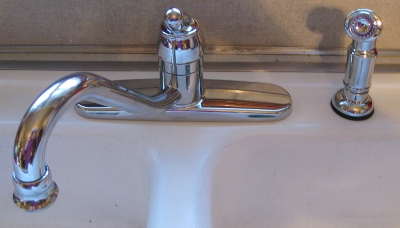 Well, that’s what it’s supposed to look like. Because we have a portable dishwasher, our faucet has to have an adapter on the end of the spigot; it was this that severely limited our choice of hardware. It seems that modern faucets usually have some kind of fluted end, many with sprayers built into the spout, and we can’t hook our dishwasher onto any of those. It may be 1952 in our kitchen, but the dishwasher is a critical part of our 2010 life, so fancy faucet tips were out of the question.
Well, that’s what it’s supposed to look like. Because we have a portable dishwasher, our faucet has to have an adapter on the end of the spigot; it was this that severely limited our choice of hardware. It seems that modern faucets usually have some kind of fluted end, many with sprayers built into the spout, and we can’t hook our dishwasher onto any of those. It may be 1952 in our kitchen, but the dishwasher is a critical part of our 2010 life, so fancy faucet tips were out of the question.
Our new faucet doesn’t look quite as nice (or maybe just doesn’t look quite as finished) with the dishwasher adapter on the end:
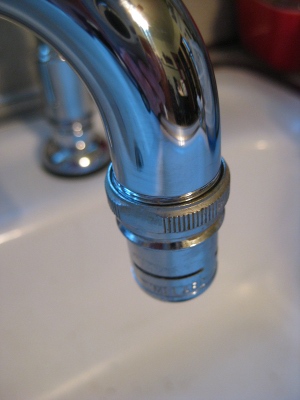 But it stands a lot taller than the old one, swings out of the way much more effectively, and, although we don’t use it, it’s a lot nicer to have a sprayer installed in the fourth hole than an ill-fitting blank. (By the way, I did have to uncoil the sprayer hose under the sink and let it sit for a day before it un-kinked enough to allow us to lift the sprayer head.)
But it stands a lot taller than the old one, swings out of the way much more effectively, and, although we don’t use it, it’s a lot nicer to have a sprayer installed in the fourth hole than an ill-fitting blank. (By the way, I did have to uncoil the sprayer hose under the sink and let it sit for a day before it un-kinked enough to allow us to lift the sprayer head.)
Because we realize that we’re likely to sell our house someday, I put the correct head into a plastic bag, labeled it, and taped it to the pipes under the sink. That’s so that we will have it handy when the real estate agent explains that we’d better get the house in shape to sell it.
Related: Sinking, Not Sewing

Thanks for the tutorial! I will be performing the same task tonight on a nearly identical faucet.
I appreciate the photos and diagrams and will likely have a much easier time tonight!
Thanks!
Good luck, Ben! One additional bit of advice (which I’ll add to the post, too): I found that the toggles that go across the holes underneath the sink tended to slip, so I picked up a couple of large washers and threaded them onto the bolts before replacing the toggles. The washers provide a more stable resting place for the toggles than just having the open hole, and allows the faucet assembly to seat more effectively.
Run HOT water through the sprayer and it will unkink in no time.
Smart! Thanks for the tip!